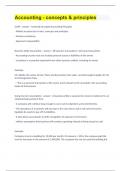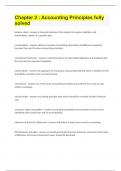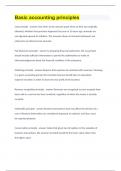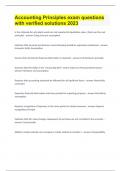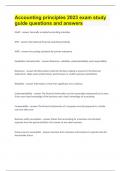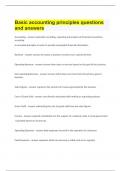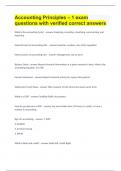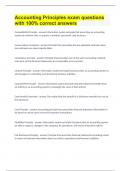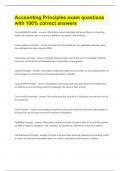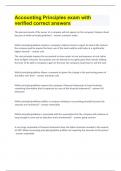Minnesota School Of Business
Latest uploads at Minnesota School Of Business. Looking for notes at Minnesota School Of Business? We have lots of notes, study guides and study notes available for your school.
-
59
- 0
-
4
All courses for Minnesota School Of Business
Latest notes & summaries Minnesota School Of Business
GAAP - Generally Accepted Accounting Principles - Widely accepted set of rules, concepts and principles - Achieve consistency - Approach comparability Business Entity Assumption - All business transactions ≠ personal transactions - Accounting records must not include personal assets or liabilities of the owner. - a business is accounted separately from other business entities, including its owner Example: Mr. Adolfo, the owner of Hair, There and Everywhere hair salon, recentl...
balance sheet a financial statement that reports the assets, liabilities, and stockholders, equity at a specific date. comparability ability to compare accounting information of different companies because they use the same accounting principles. conceptual framework a coherent system of interrelated objective and fundamentals that can lead to consistent standards. conservatism the approach of choosing an accounting method when in doubt that will least likely overstate a...
Cost principle Cost refers to the amount spent when an item was originally obtained, whether that purchase happened last year or 10 years ago; amounts are not adjusted upward for inflation. The amounts shown in financial statements are referred to as historical cost amounts Full disclosure principle In preparing financial statements, the accountant should include sufficient information to permit the stakeholders to make an informed judgement about the financial condition of the ent...
Economic Entity company keeps its activity separate from its owners and other businesses Going Concern company to last long enough to fulfill objectives and commitments - assumes that any entity will continue to operate indefinitely. In this basis, assets are recorded based on their original cost and not on market value. Assets are assumed to be used for an indefinite period of time and not intended to be sold immediately Monetary Unit money is the common denominator; currenc...
GAAP Generally accepted accounting principles IFRS International financial reporting standards ASPE Accounting standards for private enterprise Qualitative characteristics Relevance, reliability, understandability and comparability Relevance All information useful for decision making is present in the financial statements. Helps users predict future performance or confirm previous predictions Reliability Information is free from significant error and bias...
Accounting systematic recording, reporting and analysis of financial transactions according to accepted principles in order to provide meaningful financial information Revenue amount of money a business receives over a period of time Operating Revenue income from sales or services based on the goal of the business Non-operating Revenue income which does not come from the primary goal of business Sales Figures represent the amount of revenue generated by the busi...
What is the accounting Cycle? Analyzing, recording, classifying, summarizing, and reporting External Users of accounting info: Investors, Lenders, very strict regulation Internal users of accounting info: Management, not as strict Balance Sheet Reports financial information at a given moment in time. Mimics the accounting equation. A=L+OE Income Statement Reports financial activity for a given time period Statement of cash flows Tells reviewer of info whe...
Compatibility Principle Information system principle that prescribes an accounting system to conform with a company's activities, personnel, and structure. Conservatism Constraint Principle that prescribes the less optimistic estimate when two estimates are about equally likely. Consistency Concept Principle that prescribes use of the same accounting methods over time so that financial statements are comparable across periods. Control Principle Information system princi...
Measurement Principle Records assets in the accounting records at their cost or purchase price Revenue (Revenue Recognition) Principle States that revenue is recognized when it is earned Matching Principle Reports the expenses incurred in generating the revenue in the same period as the revenues are shown as earned by a company Cost Principle Records assets in the accounting records at their cost or purchase price Revenue Recognition States that revenue is recogn...
The personal assets of the owner of a company will not appear on the company's balance sheet because of which principle/guideline? economic entity Which principle/guideline requires a company's balance sheet to report its land at the amount the company paid to acquire the land, even if the land could be sold today at a significantly higher amount? cost The cost principle requires the accountant to show assets at cost and expenses at cost rather than at higher amounts. Accountants are...

